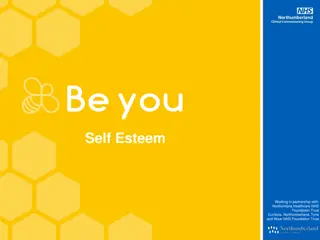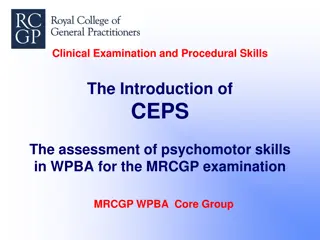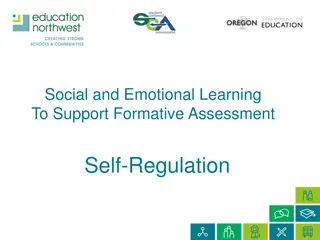Self-Assessment of LIS Students' Eportfolio Development Using Sense-Making Methodology
Explore how LIS students assess their personal growth and direction through Dervin's Sense-Making Methodology applied to intrapersonal examination of their eportfolio development. The study aims to enhance students' sense of purpose, inform curriculum improvements, and promote reflective learning through eportfolios.
Download Presentation

Please find below an Image/Link to download the presentation.
The content on the website is provided AS IS for your information and personal use only. It may not be sold, licensed, or shared on other websites without obtaining consent from the author.If you encounter any issues during the download, it is possible that the publisher has removed the file from their server.
You are allowed to download the files provided on this website for personal or commercial use, subject to the condition that they are used lawfully. All files are the property of their respective owners.
The content on the website is provided AS IS for your information and personal use only. It may not be sold, licensed, or shared on other websites without obtaining consent from the author.
E N D
Presentation Transcript
Proposal for a qualitative study of LIS students' self-assessment of growth and direction using Dervin's Sense-Making Methodology applied to intrapersonal examination of their ongoing eportfolio development Linda Z. Cooper Graduate School of Library and Information Studies Queens College, CUNY Libraries in the Digital Age Zadar, Croatia June 16, 2014
Why did I want to do this study? Our students are required to complete a culminating research project The project must be substantial Ideally the project should be: Meaningful to the student researcher Support interests that have developed and/or matured It is desirable to consider the topic/direction of this project sometime before it needs to begin Linda Z. Cooper 2
Potential benefits of this study Participants will have a better sense of direction and purpose as they move toward their culminating project Wider use of eportfolios in the department Data collected may inform the department regarding improvements that can be made in overall program and curriculum Linda Z. Cooper 3
Eportfolios A digitalized collection of artifacts, including demonstrations, resources, and accomplishments; text-based, graphic, or multimedia; multiple levels of access Show student progress and encourage student participation in learning Help students understand goals, reflect on what they have learned Provide an excellent venue for learners to piece together new and old information to construct personal understandings Linda Z. Cooper 4
Eportfolios more good things Achievement has been found to be positively correlated with higher order thinking skills (Cheng & Chau, 2013; Tochel et al, 2009; Alexiou & Paraskeva, 2010) Support student reflection by emphasizing both process and product in learning (Cheng & Chau, 2013) Self-assessment can be both valid and reliable/ consistent teachers and end term exam results (Chang, Liang, & Chen, 2013) Evaluation of student eportfolios across a program can be used for by administration for curriculum and program assessment (Buzzetto-More, 2010; Reardon & Hartley, 2007) Linda Z. Cooper 5
Dervins Sense-Making Methodology (SMM) "[D]eveloped to study the making of sense that people do in their everyday experiences" (Dervin, 1992) Discontinuity is at the core of SMM reality changes with every step we take SMM describes our movement from moment to moment and how we construct sense from our world When we come to a point where we cannot make sense, we have come to a gap and need to bridge the gap in order to continue our journey Linda Z. Cooper 6
How to bridge the gap? Sense-Making Methodology interview questions Sense-maker is the focus of the query rather than any particular system Rather than ask "What information can I get for you from our library?" a question might be "What has brought you here?" The first question predicates a solution that is supplied by the library system. The second question focuses the information seeker Linda Z. Cooper 7
Sense-Making Methodology interview questions (continued) Attempt to understand the information seeker's situation by asking about helps, hindrances, muddles, and feelings that the information seeker has experienced Use of "verbing" as opposed to "nouning" to emphasize the notion of discontinuity and constant change. Focusing on verbs in Sense-Making reminds us that sense is constantly. Verbing example: What did you like doing the most in your LIS studies? What do you think explains your liking? Linda Z. Cooper 8
Rationale Why eportfolio + Sense-Making Methodology? SMM and learning via eportfolios both embrace constructivist ideals, value reflection and self-guided direction. SMM is a means to study the constructing that people do to make sense of their experiences. Eportfolio construction (constructing) is a means to gather and arrange experiences/information to organize it and make sense of it. SMM focuses on behavior changes over time. Eportfolio building is a constructive process that takes place over time. Pairing SMM with the eportfolio reflection may be a means to help connect the discontinuity regarding direction of study to a point where sense is made and a gap can be bridged/a direction is clarified. Linda Z. Cooper 9
Methodology - Background Making Connections mini grant 2008-2009 Met with other educators from a wide geographic area to learn how electronic portfolios had been successfully implemented other schools and worked together to plan similar initiatives in our own schools Working together with the Queens College Center for Teaching and Learning and constituents across campus, a decision was made regarding the eportfolio platform that best suited the needs of all constituents Linda Z. Cooper 10
Methodology - Participants All participants will be graduate level LIS students studying to be teacher librarians All teacher librarian students in this program are required to keep eportfolios containing both voluntary and prescribed entries including a Learning Matrix keyed to AASL standards Participants for the study will be self-selected and solicited via a posting to the general student list serve directed to the attention of teacher librarian students who have both maintained their eportfolio AASL Learning Matrix throughout their course of study and plan to take the culminating research course during one of the following two terms Linda Z. Cooper 11
Call for participants [P]participants for a research study examining the use of Sense Making Methodology to help students prepare for selecting a research topic for LBSCI 709 Research in Library and Information Studies. Participants for this study need to be: LMS students who have maintained the AASL Learning Matrix in their eportfolio throughout their LMS courses Planning to take LBSCI 709 in Fall 2014 or Spring 2015 Participants will be asked to review their eportfolio and AASL Learning Matrix and then complete and submit an anonymous questionnaire regarding their professional and/or scholarly interests, both enduring and developing, during their time at GSLIS. Linda Z. Cooper 12
Prompt This exercise is meant to help you toward a better sense of your direction and focus as you move to begin your course 709 Research in Library and Information Studies. Please do your best to respond to the following self- interview. There are no right answers and the purpose is to assist you in digging deeply into your recollections, thoughts, questions, and feelings. Please review all parts of your eportfolio, especially the Learning Matrix which notes the assignments you have entered, to assist in recalling aspects of your progress through this program, both helps and hindrances, before you respond to these questions. Linda Z. Cooper 13
Interview situation Researcher not in room Participant name not on response sheet Response deposited in common envelope Response time about 30 minutes Participants received a $15 gift card Linda Z. Cooper 14
The self-interview questions Constructed in the spirit of Dervin's (2008) core questions to be used in Sense-Making Methodology interviews Dervin's core questions attempt to focus on a person's movement through time and space by querying situations, gaps, bridges, outcomes, struggles, evaluations, and helps SMM is recursive in order to focus deeply on each question, however, modified here to simplify process and because of time considerations Linda Z. Cooper 15
Self-interview questions What led you to enter study in library and information science? Think here not only of events and experiences but also struggles, questions, and conclusions. (This question queries, for example, situation, struggles, gaps, bridges.) 1. What did you hope to accomplish...what were your interests at the time you decided to enter LIS study? (This question queries, for example, outcomes sought.) 2. Linda Z. Cooper 16
Self-interview questions As you moved through your studies, what were the big things that helped you and how did each help you? (This question queries, for example, bridges that helped to cross gaps.) 3. What did you like doing the most in your LIS studies? What do you think explains your liking? (This question queries, for example, outcomes sought or obtained.) 4. Linda Z. Cooper 17
Self-interview questions As you moved through your studies, what were the big things that hindered you and how did each hinder you? (This question queries, for example, situation and gaps.) 5. What did you like doing the least in your LIS studies? What do you think explains your disliking? (This question queries, for example, struggles and situation.) 6. Linda Z. Cooper 18
Self-interview questions Thinking about your LIS studies, would you say there were experiences from your life before coming to LIS that impacted you during your studies? What were these and how did each impact you? If more than several, can you choose one or two that stand out the most in your mind? (This question queries, for example, situation and outcome.) 7. Thinking again about your LIS studies, would you say there were current life experiences that impacted you during your studies? What were these and how did each impact you? (This question queries, for example, situations and outcomes.) 8. Linda Z. Cooper 19
Self-interview questions Now, towards the end of your studies for an MLS, how does your outlook or destination differ (if at all) from your sense of these at the beginning of your studies? If you see things as having changed, how did they change? What do you see as accounting for the change? (This question queries, for example, evaluation.) 9. 10. At this time, what is your sense of what you would like to do in your culminating project? How do you see this as potentially helping you - - serving your needs and interests? (This question queries, for example, outcomes sought.) Linda Z. Cooper 20
Planned analysis Grounded attempt Will examine responses for broad concepts emerging from data Concepts will be placed into groups having a commonality noted by researcher Groups examined for insights into participant experience, growth, perceptions, anything else Linda Z. Cooper 21
Follow-up Idea: invite participants for a second round of questions regarding what they have learned (if anything) from participating in an SMM study Did participation affect choice of topic for culminating project? Did it affect anything else i.e. outlook, self- knowledge? If you had a magic wand question: If you could wave a magic wand, what would you wish to happen as you move forward? Linda Z. Cooper 22
Hopes Reflection at this point in their studies will help participants to make more informed decisions regarding culminating project Wider application of eportfolios within the department Data may inform improvements in program and curriculum Linda Z. Cooper 23
Thank You Thank You Dr. Linda Cooper Associate Professor Graduate Advisor LMS & Coordinator LMS Programs Graduate School of Library and Information Studies Queens College, CUNY linda.cooper@qc.cuny.edu Linda Z. Cooper 24























